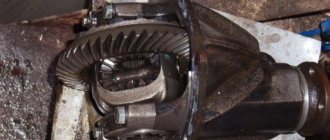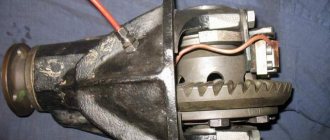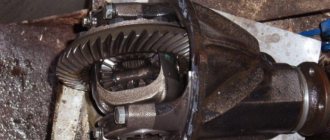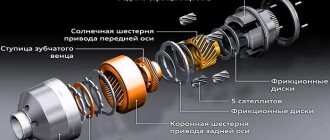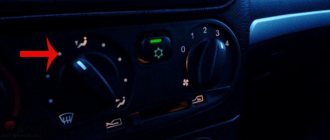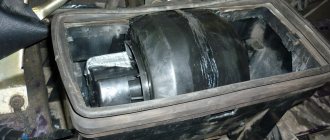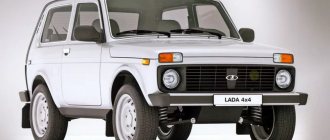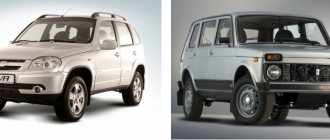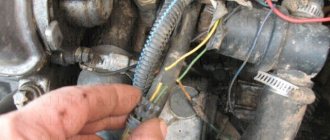Since the Chevrolet Niva is a priori an all-wheel drive vehicle, switching to all-wheel drive means turning on the locking of the center (but not the cross-wheel) differential of the transfer case. This is necessary in order to use all the wheels of the Chevy Niva in the event that one of them, say, is hanging on a lever above a hole. Unfortunately, this will not help if two wheels are suspended simultaneously along one side of the car or diagonally (this is called “diagonal hanging”). To prevent such troubles, some Niv owners (not only Chevrolet brands) install cross-axle differentials (self-blocks) with their own hands.
We help with all our wheels
How to enable all-wheel drive on a Chevrolet Niva? You can block the center differential of the Chevy Niva both when the car is stationary and while driving.
This is done with the clutch pedal depressed using the transfer case control lever, which is located behind the large gear selector. When the lever is in the neutral position, you need to pull it towards the driver. If you then press in the opposite direction, a lower gear will be engaged with a center differential lock and a gear ratio of 2.1. If you pull it towards you, a lower gear is activated (gear ratio 1.2).
When the lever is in this position, the corresponding yellow pictogram lights up on the dashboard. If you cannot follow these instructions, try repeating the procedure while driving the vehicle.
The correct sequence for engaging the rollover lock is given in the owner's manual for that vehicle. It states that such blocking must be carried out in advance, while the car is moving along a section of the road with a hard surface. The action must be performed when changing the steering wheel position. To prevent breakdowns and damage to differential parts, blocking is prohibited during slipping or when the wheels (wheels) are sliding. The mode is switched using the same lever.
If the lock does not turn on using the specified method, do not use excessive force. Just repeat the entire sequence of actions from the beginning.
Switching to a lower gear is also allowed without stopping the Niva completely, but this can only be done by experienced drivers. The fact is that the transfer case, unlike the gearbox, does not have synchronizers installed. Changing from a lower gear to a higher gear while the car is moving is undesirable, although it is allowed in extreme cases.
It is not recommended to keep the center differential of the wheels in locked mode at all times, especially when driving on asphalt roads, as this will not only lead to increased fuel consumption by the vehicle and poor handling, but also to the breakdown of expensive transmission components.
Types of cross-wheel differential devices
The Chevrolet Niva SUV is equipped with standard cross-wheel differential devices that do not require forced blocking. But the designers foresaw this and produced several types of differentials with a built-in forced locking mechanism. They can also be installed on an SUV such as the Chevrolet Niva.
Among such differential devices, the following types are very popular today:
- With a pneumatic type connection - using compressed air (the blocking is controlled by the driver from the car interior using a silicone hose).
- With an electrical connection - using a cam mechanism (the locking is activated using electromagnets).
- With self-locking (their peculiarity is that they are not controlled by the driver).
Auto mechanics warn that the positive locking mechanism installed on the differential device can excessively exceed the loads on the axle shafts and transfer case. Because of this, failure of both the axle shafts and the transfer case is possible.
see also
Comments 18
If you were steering in 3D and not riding as a passenger, then the principle is the same, only there is one lever on the steering wheel. I switched from Niva to Sh-Niva and no questions arose.
I had 2 fields, then a lot of things now Shng, and in the blog there are a lot of entries that I did myself until I got used to it
Well, with one lever on the RK it’s even easier. I meant the principle of using lowering, raising and blocking.
from the right back - high gear, spins one of the four wheels! from right to front - low gear (for a large hill, sand, swamp, etc.) and also one of four! to the left in the back - increased, the center differential is blocked, both axles are turned (but one wheel from each) to the left in the front - low, well, the same crap as in the line above! I advise you to turn on the lock only when you are stuck! or I'm sure you might get stuck! For everyday driving, do not turn it on even in winter!
From the neutral position to the left downwards the high gear is engaged with the MD locking, the left forward position is engaged in the lower gear and the MD locking, the position to the right up is engaged the lower gear, the right downwards the higher gear is engaged (everyday road conditions)
Read more: ZAZ chance manufacturer country
Between the axle differentials, it’s difficult to turn on and off its locking as described...
Damn, I still don’t understand along the highway to the right down through the mud to the right up and why do the rest
Then, according to the diagram that you wrote in the mud, the car will turn into an underdrive, the torque will not spread to the front axle! The transfer case has the same differential as the axles, so if the rear wheels start to slip, all the torque will go to them and the front wheels will be silent. To prevent this from happening, there is a lock for this differential and then it will be 4x4
oh my god, I think I’m not stupid, I drove a 3D Niva, but I still don’t understand this one, I realized that the track is right back, the track is right forward, it’s dirt and the rest doesn’t fucking understand
Look, in 3D there it is divided into two levers, the small lever is MD locking, the large lever is lowered and higher. Which ones did you use?)
Damn, I still don’t understand along the highway to the right down through the mud to the right up and why do the rest
If the dirt is serious, then turn it up to the left, if everything is not serious, then it will go anyway)
TO THE RIGHT (AWAY) AND BACK - HIGH, RIGHT AND FORWARD - DOWN, RESPECTIVELY. IN THE MIDDLE BETWEEN THEM THERE IS A NEUTRAL POSITION, AND IF FROM THE NEUTRAL POSITION YOU SWITCH TO THE LEFT (TO YOURSELF) AND BACKWARD - HIGH WITH LOCKING AND, ACCORDINGLY, IF TO THE LEFT AND FORWARD, LOWER WITH LOCKING. USUALLY HIGH - LOW IS EASILY TURNED ON, BUT TO MOVE FROM NEUTRAL TO HIGH - LOW WITH LOCKING, YOU NEED TO STOP AND IF IT DOESN’T TURN ON, THEN TURN ON THE REAR AND Slightly LOSEN THE MESH OF THE GEAR TEETH, THEN EC THOUGH - RELEASE THE CLUTCH A LITTLE SO THAT THE GEARS LOOSEN, THEN PRESS THE CLUTCH AND ENGAGE THE LOCK.
thank you, it’s terrible that such information won’t fit, but it’s just that on the highway it turns out you need to RIGHT (AWAY) AND BACKWARD, and in the mud RIGHT AND FORWARD - LOWERED
SO EXACTLY, WELL IN PRINCIPLE, YOU DO NOT NEED TO PUSH THE LEVER AWAY FROM YOURSELF, IT IS ALSO ON THE RIGHT SIDE, BUT IF YOU NEED LOCKING SOMEWHERE, THEN THE SAME THING IS, ONLY THROUGH THE NEUTRAL TO YOURSELF - HIGH-LOW WITH LOCKING.
But what about the blocking, sorry, I’m stupid, the first day I bought a shniva, well, the blog will be full of information
IF LOCKING IS NEEDED SOMEWHERE, THEN DO THE SAME, ONLY THROUGH NEUTRAL TO YOURSELF - HIGH - LOWERED WITH LOCKING. 1 PRESS THE CLUTCH, PLACE THE TRANSFER LEVER IN THE NEUTRAL POSITION. 2 PULL THE LEVER TO YOURSELF (TO THE LEFT) AND TURN ON: BACK - HIGH WITH LOCKING OR FORWARD - LOWER WITH LOCKING. WHEN THE LOCKING IS NO LONGER NEEDED (HAVE LEFT OUT OF A HUGE MUD PUDDLE), THEN IN THE REVERSE ORDER - 1 PRESS THE CLUTCH, PUT THE TRANSFER LEVER IN THE NEUTRAL POSITION. 2 MOVE THE LEVER AWAY FROM YOU (to the RIGHT) AND TURN ON: BACK - HIGH WITHOUT LOCKING (ON THE HIGHWAY OR CITY - NORMAL DRIVING) OR FORWARD - LOWER WITHOUT LOCKING (DIFFICULT AREAS)
Read more:
The Chevrolet NIVA SUV is equipped with a five-speed gearbox, as well as a transfer case with a range and a center differential lock.
When purchasing this car for the first time, the car owner does not always know how to use such a transmission correctly, when and under what conditions it is necessary to engage the lock, and when to lower it.
When to use a differential lock
The Chevrolet Niva has high cross-country ability in all types of off-road and mountainous terrain. Many of them can be easily overcome with a locked differential. This driving mode is recommended:
- on roads with reduced cross-country ability;
- on steep ascents and descents;
- when moving on dry (loose) sandy surfaces;
- when driving on ice, deep snow or crust.
As a conclusion, the story “How to turn on all-wheel drive on a Chevrolet Niva: diagram and video instructions” is offered. By the way, it is recommended to lock the car at least once a week, especially in winter.
An integral part of the transmission, providing the VAZ SUV with all-wheel drive, is the Chevrolet Niva transfer case. Since control of the unit is included in the list of manipulations performed while driving, each driver must have a general understanding of the purpose of the transfer case, its structure and operating rules.
What is a differential and what is it used for?
The differential has the form of a mechanical installation with a set of planetary gears and shafts. It is designed to distribute torque from the engine of a Chevrolet Niva car to the drive wheels, which are mounted on the same axle. This allows the wheels of the car to spin at different speeds. Rotating the wheels at different speeds is very important when turning a car, when one wheel passes a small radius and the other a large one. In the absence of a cross-axle differential, this would lead to spinning (slipping) of the wheel, which covers a smaller radius. A single wheel slipping would cause the vehicle to skid and increase tire wear.
When a car moves in a straight line at a constant speed, then the thrust from the engine to the wheels is distributed evenly. This helps both drive wheels rotate at the same speed. When one of the drive wheels slips, the differential automatically distributes the traction force from the engine. At the same time, the force on the slipping wheel increases and decreases on the stationary one. Typically, cars have only one differential installed in the drive axle. There are three of them installed on Shevik:
- Two differentials are installed in the front and rear axles of the car, which allow the drive wheels to rotate on the same axle at different speeds.
- The third is central (interaxial action). It helps distribute torque from the engine to both axles of the vehicle.
Chevrolet Niva differential lock
SUVs, including the Niva, have the ability to lock all three (cross-wheel locks are installed optionally) differentials. Thus, the vehicle’s maneuverability in harsh off-road conditions increases many times over.
When one wheel of the car slips, through the differentials, traction force will be transmitted from the engine to this wheel. All other wheels will be at rest, since the traction force will not act on them. Thus, the car will be immobilized. For example, while one wheel is slipping in a hole, the remaining wheels will be at rest. This means that all the traction force will be transferred specifically to the slipping wheel and will contribute to its rotation.
The purpose for which forced differential locking is turned on is to unite the drive wheels with each other, while ensuring their rotation at the same speed. Blocking makes it possible to make maximum use of the traction force transmitted from the car engine.
The operating principle of the differential lock on a Chevrolet Niva. As you know, a differential consists of gears and shafts, which make it possible to automatically distribute torque from the engine to the wheels. Forced differential locking prevents the gears from rotating, which is achieved using a special locking clutch. Thus, when the lock is manually engaged, the driving wheels of the car are rigidly connected to each other. This connection allows the wheels to rotate at the same speed. When the center differential lock is engaged, the drive shafts of the front and rear wheels are rigidly connected to each other, thereby providing uniform torque to the front and rear axles. The vehicle's cross-country ability increases, which makes it possible to be the first of its kind in SUVs. When the traction of the car's wheels is better, the more traction power the car will receive.
When is it necessary to use a differential lock?
Not all cars have the ability to lock the differential, which makes these cars more vulnerable off-road. And sometimes it happens that now it would be useful to have two axles on a car. The Chevrolet Niva is a unique car that has great cross-country ability on all types of off-road and even mountain surfaces. Forced blocking is used in the following cases:
- When the vehicle overcomes difficult road sections. The blocking is activated prematurely, before entering such a road.
- On steep slopes or mountainous areas where there is a possibility of wheel slip.
- When driving on a dry sandy road.
- When the road is covered with a layer of ice or snow crust.
When to use low gear
For what purposes is a transfer case even needed, when does it make sense to engage the locking and downshift? Such seemingly simple, but at the same time serious questions will become clear when considering the following example. When driving on a country road on a hard surface, fourth gear is engaged. Suddenly, a large puddle with a soft, unreliable surface appears in front of the car. In such an obstacle the car can easily “sink”. To prevent this, you should engage a lower gear and slowly overcome such an obstacle without haste. This gear is designed specifically for driving on soft road surfaces, when even in first gear the car feels “hard”.
It is worth noting that in order to engage a lower gear on a Niva Chevrolet, you need to stop - this is how the car’s differential is designed. But you don’t need to stop at all to turn the lock on and off. But is it worth using such additional and, without a doubt, useful functions of the machine often? Experienced drivers recommend using them in places where the dirt is not located on level ground, but with various potholes and the like.
Thus, the low gear of the Chevrolet transfer case is designed for comfortable off-road driving and overcoming various obstacles. In such a gear you need to drive slowly, you cannot accelerate sharply, because at this moment the wheels will receive a large load, as a result of which a real hole can form, from which it will be very difficult for the car to get out.
With this driving style, the motorist will better feel the movement of the wheels, as a result of which, when they “bury”, as evidenced by the chaotic movement of the car, it will be possible to immediately do something after overcoming the obstacle. Most often, this is done by changing the trajectory of the car.
It is also worth noting that when driving through sticky mud or deep puddles, you should never suddenly engage second downshift. At the same time, the torque increases, as a result of which the car can simply “choke”, stalling at the most inopportune moment.
Functional purpose of the device
A rigid blocking is used on the Niva to balance the incoming load. The process is based on the unevenness of the path traveled by each wheel. The sides located closest to the center travel several times shorter than the wheels located on the outer side. At low travel speeds, some of the rubber wears out faster, and at high speeds, skidding occurs.
Electronic differential locking helps to avoid the above. In good condition, it transmits torque from 1 source to 2 different consumers. In order to understand how the mechanism works, it is necessary to imagine the following: from 1 source, each consumer receives a torque of different physical parameters. If the differential lock is set correctly, the difference in the amount of torque received ensures safe rotation of the wheels along the inner and outer radius. Physical wear or mechanical damage increases the likelihood of a skid accident
When operating a VAZ 2121 on roads with unsatisfactory surface quality, the importance of the differential increases
All-wheel drive vehicles, whose axles are coordinated by a differential, distribute torque evenly to all wheels. In case of slipping, the system automatically transfers maximum torque to them. The switching process does not take much time. In the event of a malfunction, 2 wheels slip, while the other 2 remain stationary. Differential locking helps to avoid this.
It forcibly distributes torque evenly over the front axle, between it and the axles. In case of temporary slipping, the device will provide the necessary uniform force to increase the quality of traction.
Transfer case purpose
If you create a permanent all-wheel drive in a car and provide constant torque on the driveshafts of the rear and front axles, then such equipment is capable of overcoming obstacles such as off-road, but no more. However, the car will not be suitable for driving on the highway at relatively high speeds.
- There will be an excessive load on the parts that distribute the moment along the axes.
- Fuel consumption will increase.
- There will be a rubber eating effect.
The transfer case on a Chevrolet Niva car performs two functions at once. It ensures the distribution of torque along the axes with the possibility of supplying it to both axles simultaneously.
The transfer case also converts torque, increasing it by lowering the speed in gear. Here, transmission means a pair of gears that are in mesh and have a certain gear ratio. These two functions can be performed together or separately.
Which is better to install a self-locking differential on the Niva?
A domestic SUV can be equipped with an electronic, combined, mechanical or pneumatic self-block. The first type model has a significant advantage over other versions. To activate it, you just need to press a button. The mechanism operates automatically, but only if the car is moving at a speed that is less than the threshold. The system shuts down when it reaches a mode higher than the nominal parameter.
The pneumatic version is a device mounted on both axles. The advantages of the mechanism include its compact size; the operating principle is based on the use of a pneumatic system. Self-block mechanical type is the cheapest and simplest in design. Reliability and operational efficiency depend on two semi-axial and a pair of spacer couplings, as well as pins and springs.
Power steering
The car is equipped with power steering, which significantly reduces the force on the steering wheel. If the power steering is not functioning (for example, when towing a vehicle with the engine not running), you can still steer the vehicle, but you will need to apply significantly more force to the steering wheel to do so. In extreme positions of the steering wheel, functional noise is allowed.
Warning
- Do not coast with the engine not running! In this case, the power steering does not work, putting you and other road users at risk.
- It is not allowed to hold the steering wheel in extreme positions for a long time.
Device
The military line of GAZ all-terrain vehicles "Tiger" is a military analogue that has at least the third category of ballistic protection in the area of the stern, sides and frontal part. The roof of the vehicle is equipped with a large hatch with a pair of flaps and a rotating lid. In addition, this mechanism provides mounts for various types of weapons. Opening armored glass allows the use of machine guns and pistols.
The main cabin of this “M” class modification has six seats, as well as a compartment for accommodating a grenade launcher shooter and storing the corresponding ammunition. In addition - communications equipment, radio blocking devices, location devices.
Chevrolet Niva transfer case
Despite the fact that the Chevrolet Niva is presented in several modifications, the basic design of the transfer case is the same everywhere. It can be represented as a collection of independent nodes.
- Drive shaft. It takes on the entire load from the main transmission and transfers it to the transfer case.
(1 - flange; 2 - oil seal; 3 - bearing thrust ring; 4 - front bearing; 5 - drive shaft; 6 - high gear; 7 - hub; 8 - clutch; 9 - low gear; 10 - bushing; 11 - rear bearing; 12 - installation ring)
- Center differential. Provides the ability to rotate the front and rear drive shafts at different angular speeds.
(1 - retaining ring; 2 - spring washer; 3 - bearing mounting ring; 4 - differential housing bearings; 5 - driven gear; 6 - front differential housing; 7 - front axle drive gear; 8 - retaining ring of the pinion axis; 9 - satellite; 10 - rear differential housing; 1 1 - support washer; 12 - rear axle drive gear; 13 - satellite axis; 14 - spring washer of the satellite axis; 15 - support washer)
- Locking node. Provides a rigid connection between two shafts, at which they begin to rotate at the same angular speed.
- Downshift. Its purpose is to increase torque by reducing shaft speed.
The Niva Chevrolet transfer case can be controlled from the passenger compartment with one lever, so an element such as the transfer case drive is considered as a component.
As for the more detailed design diagram of this transmission element, it is quite complex and contains more than 40 positions in which structural and auxiliary elements can be distinguished.
List of structural elements
- driven gear
- Differential clutch
- Differential bearings
- Drive shaft bearings
- Axle drive shafts
- Shaft seals
- Intermediate shaft bearing
- Overdrive and underdrive gears
- Intermediate shaft
- Differential housing
- Satellite axis
- Satellites
Advantages of forced blocking from IZH-TECHNO
What are the advantages of our forced blocking over existing analogues?
Forced locking kit
The first, important point is the ease of installation and the availability of all the necessary components for installation. The differential assembly with our lock is installed in its standard place in the axle gearbox. You do not need to somehow “finish” the gearbox or purchase additional spare parts such as claw couplings or original axle shafts. Our locking is compatible with original axle shafts. All you need to install it is a standard set of plumbing tools. No “exercises” with a welding machine and grinder.
Our locking system consists entirely of original components produced by IZH-TECHNO. Therefore, we guarantee the high quality of its individual components and locking elements; In turn, the high quality of components is a guarantee that you will not need any spare parts throughout the entire service life of the product, because there is simply nothing to break in it.
We paid special attention to such a parameter as the strength of the satellite group. This is no coincidence: after all, it is she who transmits torque to both wheels of the axle and experiences the highest loads.
The strength of the satellite group is confirmed by a series of tests carried out both in laboratory conditions and in real off-road conditions.
The lock has four satellites instead of the standard two
The blocking has four satellites, instead of the standard two. This design allows for even distribution of torque and is more reliable than stock
We paid special attention to the parameters of the satellites themselves, increasing the thickness and height of the splines (see photo below):
On the left is a stock satellite, on the right is a satellite produced by IZH-TECHNO
Protection of the pneumatic drive of forced blocking. The pneumatic drive is hidden inside the axle housing and is protected from mechanical influences; it cannot be broken or damaged.
The differential housing is manufactured with high precision and strict tolerances, which ensures the absence of vibrations and noise in the axles when driving on the highway.
Niva differential housing cover
Fast locking. By increasing the number of teeth involved in the differential locking, we achieved quick response of the locking mechanism. You don't have to wait for the wheel to rotate to 120 degrees for the system to finally work. In our case, 9 degrees will be enough.
Versatility. The lock is suitable for all modifications and variants of Niva and Chevrolet Niva cars; it can be installed in both the rear and front axles, in both steel and aluminum front axle gearboxes. Locking options for 22 and 24 splines are available.
Read more about the features of forced blocking on Niva and Chevrolet Niva in the description on our website.
Transfer case control
The key to long-term operation of the transmission is the correct choice of its operating mode. Each owner of a Niva Chevrolet car can first become familiar with the operating rules using a specially developed manual. First of all, you need to understand the operating modes of the transfer case and their activation. On Chevrolet Niva cars, the downshift/upshift, as well as the locking, are activated by one lever, which has five positions.
- Central position – neutral is on.
- Back and to the right - high gear with the differential unlocked.
- Back and to the left - high gear with a locked differential.
- Forward and to the right - low gear with the differential unlocked.
- Forward and left - low gear with a locked differential.
Operating a vehicle in different modes
A lower gear is engaged when it is necessary to increase torque. An example would be driving up a steep slope or driving through sticky ground. To overcome difficult areas, the lock is activated. To achieve a clearer and more fixed engagement, you need to wait for the moment of slipping, and then, with the clutch disengaged, move the lever to the left. While locked, you can only travel a limited distance at a speed of no more than 40 km/h.
Advantages and disadvantages
To find out which is the best self-locking differential for the Niva, you need to compare the advantages and disadvantages in relation to the standard analogue of the car. The benefits include:
- Increasing the vehicle's maneuverability on steep, sliding and bumpy surfaces.
- There is no need to make changes to the design of the machine, since the self-block is mounted in place of the standard element. It is recommended to carry out installation work in a specialized workshop or do it yourself.
- The mechanism in question operates automatically and does not require special training for the driver.
Disadvantages of installing a self-locking differential on a Niva:
- steering becomes tighter, which requires additional effort;
- the working life is less than that of the factory element;
- driving style changes when cornering;
- there is no complete guarantee of blocking.
Various modifications of self-blocks have their own nuances, depending on the manufacturer, type of development, and installed components.
Transfer case malfunctions
The transfer case is a complex unit, so it is important to correctly diagnose the malfunction and be able to quickly fix it. The most common sign of its incorrect operation is increased vibration. If it is observed when driving in various modes, then the cause may be wear of the elastic coupling. A visual inspection will help verify this. Vibration under direct load (acceleration) indicates a loose attachment of the transfer case to the body, a faulty CV joint on the intermediate shaft, or a jammed joint on one of the cardan shafts. If vibration is observed at a constant speed, then there is a problem with the balancing of the cardan shafts themselves or the differential.
Malfunctions associated with difficult mode switching often occur. Here attention should be paid to the hinges of the control mechanism, as they usually become clogged with dirt. The fork or stem may be deformed. Over time, nicks appear on the splines of hubs and gears. They can be easily removed by grinding, but to identify the defect you have to remove and disassemble the entire assembly.
Preventive maintenance includes timely replacement of transmission lubricant. It is performed every 45,000 km. It is important during operation to follow the rules for switching modes, and also to carefully monitor the timely unlocking of the differential.
The video is not mine, but, as you can hear and see, this problem is not only for.
Chevrolet Niva gearbox operation
We will be grateful if you share with your friends: Other problems Sometimes there is a knocking sound in the transfer case. Turn it down - right up.
Chevrolet Niva › Logbook › Help me figure out the transfer case. everything is simple: in the field there is...
I rebuilt the gearbox - it didn't help. Just today I went to the lake to check if the ice had melted.
That’s why it’s better to do it slowly, at first.
And then he dropped the topic. Maybe this information will also help. I’m not an expert and I’ve never owned a shnivy, Patrick is closer to me. But I am a mechanic of at least 3 categories, and in some cases 4 and 5. Gear whine occurs when the gears are not properly engaged. Google it, adjust it and it won’t howl.
Well, the transfer case needs to be adjusted first. Don't forget to fill it with normal oil. I pour expensive motor oil, I have 11 in the winter, Well, the edge is with a tailwind. The speedometer on the Niva shows the weather on the moon. We're just talking about the short guy! On a slippery road at a speed of 60 or more, you constantly catch the car with the steering wheel.
Short wheelbase, the car constantly shakes. Fortunately, it steers well, but it keeps you tense. The Niva can definitely stupefy the car owner with its cross-country ability and force him to figure out where to get money for this miraculous all-terrain vehicle, which “well, you saw how it rushes! But also, almost every trip to serious off-road conditions forces the Niva owner to figure out where to get money for repairs.
Chevrolet Niva 2006, 80 l. With. - spare parts
In contrast to the suspension, it has a very weak transmission and steering system. Categorically not designed for jerking and shock loads. This increases the load on the transfer case bearings. There is a diagram on the shift lever. To engage a downshift, you need to move the lever to the right, up. To lock the differential, pull it all the way to the left.
There are also Latin letters on the lever. So, L is a low gear, N is neutral, and H is high. Now let's find out how to use all this so that we don't have to repair the mechanism and change the transfer case bearings.
So, if you have to overcome a ford or a puddle, you should stop completely and turn on a lower set of steps. Even at 5 kilometers per hour you will have problems with the transfer case. But you can lock the differential even while driving. This won't bring any surprises.
What is it for?
Unless fuel consumption increases due to the constantly working two axles and axle shafts. In what cases is it necessary to engage a downshift on a Chevrolet Niva? Please note that it should only be enabled when absolutely necessary. Otherwise, the load on the teeth and shafts increases. Forced unlocking Sometimes it happens that the lock gets stuck - it cannot be turned off even when the car is completely stopped.
The situation is quite common for the Chevrolet Niva. To do this, engage reverse gear, accelerate a little and turn off the differential lock while driving.
But if a similar lamp continues to light on your instrument panel, as in the photo below, the lock has not been turned off.
What to do in such a situation? It is necessary to turn on the first speed and try to turn off the unit again. Moving back and forth will solve the problem of a stuck differential. In general, it is recommended to turn on the center lock only in serious off-road conditions.
At the intersection of dirt roads and sand dunes, a downshift is sufficient. Overcoming a deep puddle Often a dispute arises between motorists about how best to cross a ford with a transfer case. You may ask - how long does it take to turn on the blocking and then turn it off? There is another nuance here - very often, many owners of the Chevrolet Niva have a problem with the blocking - it does not turn off.
How to use the transfer case on a Chevrolet Niva? Video review
It just jams and that’s it, you have to drive on the highway with the blockage. This, you understand, is very harmful for the machine and in such cases you must turn it off.
There are several options - turn on reverse, accelerate a little and try to dislodge the lock while driving. You need to do this at speed; it works quite often. Moreover, you can accelerate forward and also try to turn off the lock. I also got stuck once, but even then I didn’t notice it right away and it’s not a problem.
In bright sunny weather it is sometimes difficult to see. Well, about turning off the center wheel - I managed to turn it off just when reversing.
Needless to say, now I turn it on only in the most dire cases. In the rest of the others, lower gears are quite enough for me. Just today I went to the lake to check if the ice had melted.
Parameters and selection criteria
The definition of a self-locking differential on a Niva is influenced by the car model, operating conditions, driving style, and other objective and subjective factors. For example, the ball version increases the load on the steering column, which radically changes the way the driver drives. This is fully expressed during turns and turns; if handled improperly, it leads to deformation of transmission parts.
The correct approach to choosing self-blocks is to take into account which axle of the vehicle will be equipped with the specified mechanism. This is due to the fact that the number of splines differs for different modifications. There can be 22 or 24 of them. Pay attention to the markings on the packaging. Usually there is information there, is it possible to install devices for a certain brand of car? Another point is the degree of transformation of the torsional moment (0.5 or 0.7). Here the choice depends on the owner of the car.
Overtaking
Yes, comfortable overtaking and the Chevrolet Niva are poorly compatible concepts. An 80-horsepower engine is completely insufficient to perform this maneuver quickly and safely. As you know, overtaking is one of the most dangerous maneuvers and most of the most serious accidents occur during overtaking. The rule “If you’re not sure, don’t overtake” is doubly, if not triple, relevant for the Chevrolet Niva. To tell the truth, after every serious overtaking I still have sweat on my forehead, so I try to overtake only when I am completely convinced that the road ahead is clear and I can drive into oncoming traffic without the risk of not having time to return to my lane. Sometimes you’re driving behind a truck, its driver blinks at you, saying, overtake, thinking that it’s easy for you, but you stubbornly sit behind him, realizing that no matter how hard you try, you won’t be able to make it in time. Sometimes you have to say thank you over the radio and explain that you don’t have enough motor.
